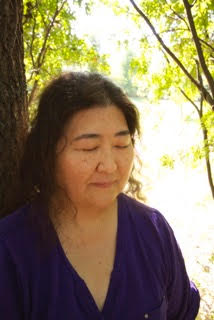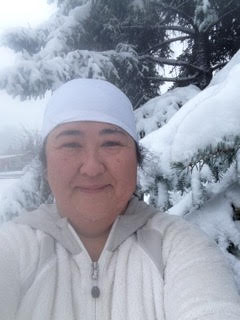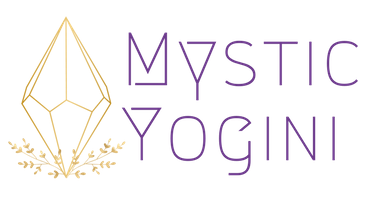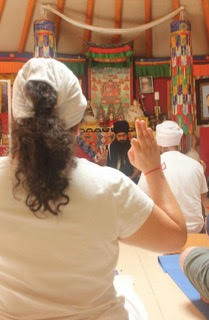It is my pleasure to introduce to you Param Jap Kaur! She is a lovely and gentle soul filled with magic and wisdom. I really enjoyed our interview and witnessing her love of Kundalini Yoga and Mantra. She really loves teaching and shares her wisdom beautifully. Param Jap Kaur is the first teacher I’ve interviewed where her practice had huge impacts on her physical body as well as the emotional – mental – spiritual impacts.
In the second part of the interview, next week, Param Jap brings up how we can meditate and experience resistance despite our conscious choice to do said meditation. Interesting stuff!
 MY: You’ve done a lot of training in both yoga and the intuitive arts. I’m wondering how long you have been practising Kundalini yoga for?
MY: You’ve done a lot of training in both yoga and the intuitive arts. I’m wondering how long you have been practising Kundalini yoga for?
PK: I actually haven’t been in Kundalini all that long. Probably just over three years now. It is kinda of interesting because I had taken one Hatha class before, and then a friend dragged me to a Kundalini class and I just fell in love with it, especially with the mantras. So I took a few classes and then signed up for teacher training. Actually, I didn’t even sign up. I just showed up and asked if I could join the class. {Laughter}
MY: Wow, that was fast for you.
PK: Yeah, well, it was kind of funny because I have a very intuitive friend who took teacher training before me. She kept telling a couple of us “you need to go take this training” and she rarely says need, but she kept telling us, “you need to go.”. So, this other friend of mine who she told dragged me to my first Kundalini class and that’s how I got introduced to it. I wasn’t really into yoga although I had studied other modalities of healing and energy work before, and meditation especially with tai chi.
MY: You said you went to a Hatha class and then a full class. What’s the story behind the Hatha class?
PK: Oh, my sister in law teaches yoga on the coast. I was out there visiting and she took me to her yoga class. That was my first Yoga class. It was doing sun salutations. I hadn’t done yoga before – that was a year and a half or two before I went to my first Kundalini class. It was the chanting and the mantra I just love. It really resonated with me.
MY: Yeah, that’s normally what happens. People take their first class and they fall in love with it. Or they hate, but if you become a teacher it’s because you love it. What is the biggest transformation you noticed in your life after teacher training?
PK: Oh, wow. Well, to begin with, I was a lot shyer before. When I first started taking Kundalini when I would chant I would hardly make any noise at all. Now I have really found my voice and I can really project now. I’m not shy about that. I feel so much more grounded. It was the first practice amongst all the different things I did I felt total mind-body and spirit balance. Physically I changed a lot. For the first time in ten years my weight dropped below 200 pounds and I went down three clothing sizes. And that was just in the first year and a half – teacher training and after. I changed a lot physically as well as mentally and spiritually. It’s hard to say just one thing because they all happened in conjunction with each other.
MY: And what did you notice start happening after the first year and a half? Did you notice the transformations shift or become more subtle?
PK: Its an ongoing process. The more you open up to the process of your own introspection and tuning into your self , you are able to recognize your old behaviour patterns and the set ways we tend to think as well. As you deepen your practice I find you have more space to examine things like that and be more neutral. You develop your neutrality, your negative mind.
Its like you give yourself a little more room to make decisions as opposed to react. If you are not making conscious choices you are living out karma.
I did teacher training and I did Yoga for Youth in between my teacher training months. I also did winter and summer solstice that year and I also did the 21 Stages of Meditation all in that roughly year and a half time span. It was a very, very intense immersion for me into Kundalini yoga and I can honestly say the best thing I ever did for myself was to sign up for teacher training. I just wanted to learn more about it because being very new to yoga and new to Kundalini. I just didn’t know anything. I wanted more information and I was one of those people who at the beginning of the class said, “I’m just here to learn, I don’t want to teach”. About a month or a month and half after I graduated I was offered a position to teach.
It’s very ironic.
PK: I studied with Sat Daharm Kaur (lead trainer), Sat Kaur and Siri Hari Kaur in Canmore. Every two years they run a level one immersion. It’s a lovely place to be – they rent out the Bill Warren Room at the Nordic Center. It is a lovely room with nice wooden floors and floor to ceiling windows. You can stare out at the mountains and be immersed in the healing space of nature while you do the yoga.
And then we stay down in Canmore at a place called the Rocky Mountain Chalet. They have kitchenettes and two or three bedrooms. We quite often pair up with different classmates and stay together. It’s really an all encompassing immersion and throughout Sept – April, we have three days almost every month. In January we had a 9 day immersion instead of a weekend in December and February.
And I can’t say enough about the trainers. They are top notch and they all bring such wonderful points of view and different teaching styles to the course. I am still in awe of all they know and how much they give to the students.
MY: Do you teach in Calgary right now?
PK: Yes I do. I teach at Prema Health and also teach a meditation class at Like Minded People. I don’t teach over the summer at Prema Health but will begin again in September.
MY: Do you have a daily consistent practice for Kundalini yoga?
PK: Consistent? It is usually pretty consistent. I am usually in a 40 or 90 day practice of some sort. So yes, I do have a daily sadhana.
MY: But you don’t stick to the Aquarian Sadhana?
PK: No, I have to be at work at 6.30 so I don’t usually have 2.5 hours in the morning to do that. I do enjoy meditating in the morning so I will do that and sometimes a short kriya and I listen to japji on the way to work. It is twenty minutes so it fits perfect. And I usually listen to the mantras first thing in the morning in my office. So in a way it’s Aquarian but its not.
MY: It sounds like you’ve really adapted it to your lifestyle.
PK: Well, that’s the joy of Kundalini. As Yogi Bhajan says, its yoga for the householder. It’s so wonderful. It gives us so many different tools for whatever we are going through in life. There are kiryas and meditations you can do to help yourself through these situations. It is adaptable. If you can spare three minutes and that’s your practice then that’s what it is. You just do what you can when you can. Everything you do is an investment in your own well-being.
MY: That’s so true. Do you have a certain meditation you are working through right now you wouldn’t mind sharing?
PK: I just finished the Grace of God meditation.
MY: Oh, with Ardas Bahaee?
PK: No. It’s saying I am the Grace of God. It’s done twice a day. Lying down you hold your breath in and repeat I am the grace of god ten times, exhale and hold your breath out and repeat I am the grace of god ten times. You do that five times in a row. Then you sit up. Right hand is in gyan mudra and left palm is facing out. You concentrate on each of your fingers in turn beginning with your pinky and say I am the Grace of God out loud 5 times while and concentrate on the qualities of each finger.
MY: That sounds amazing.
PK: It is; it is a beautiful little meditation.
 MY: What did you notice change in your life because of that meditation? I’m always curious what the results are.
MY: What did you notice change in your life because of that meditation? I’m always curious what the results are.
PK: Well physically I thought it was great because I was learning to hold my breath out longer. I also found that really meditating on the sound current of what you are saying and reflecting – especially when you are doing it with the fingers and you are reflecting on the qualities like communication – how much more connected I am to that. It was somewhat liberating in a way I found. It made me more expansive into these areas of my life when I reflected up on it.
MY: Cool. When you teach your classes do you have a certain person you focus on teaching? Or do you teach anyone who feels the call to Kundalini Yoga?
PK: I feel fairly open to teaching anybody who is willing to sit there and learn. I try not to have any agenda. I do like to teach in set programs, like for example a series on the chakras, or a series for the ten bodies, or a program for stress. I find, in my experience teaching, that doing it that way rather than no set program there is more cohesion for the students with the program. I think they felt it more deeply that way too as they build upon each week. Sometimes I give them homework. I try to anyways. I encourage them to do one of the meditations or pranayams at home during the week or the days they are not in class.
MY: Very cool. I like that. I like giving my students homework too. I find that a lot of people, at least in my classes – I predominantly work with women who’ve experienced trauma. I find that a lot of them will just take the kriyas and do the kriyas as best they can for the entire week. The next time I see them the next class they are like “Oh my god its so amazing!”. I don’t generally find I have to assign homework because they are so into it because they can feel how its affecting them.
PK: That’s great. I’ve definitely had some people come up and ask how can I do this and where can I find this to do at home. It’s such a thrill to see people get excited about it as much as we get excited.
MY: Yes, it really is. I really like the idea of giving homework out too, because I never really thought about it before, people just would approach and ask or just do it. I am totally going to start doing that.
PK: It helps just to get them thinking about it more. I usually start with pranayams at the beginning just to get them more connected to their breath and asking them just to see what their experience is, even if its only three minutes. To see if they notice any changes before and after it. Just to give them more self awareness. And if they are practicing in between classes it will help sustain change.
MY: If someone came up to you and they were a total newbie – I guess you’ve already talked about this – but they wanted to start a daily consistent practice of Kundalini yoga what would you tell them to do?
PK: Well, again I would encourage them to start with pranayam. I also recommend too, if they want guidance at home or don’t feel confident doing a kriya on their own, there are wonderful Youtube videos out there that some of the Kundalini yoga teachers have put together.
MY: Is there a particular pranayam you would recommend for somebody to start with or is it based on the person asking?
PK: Usually based on the person. It’s been my experience too that people who are very stressed out often have trouble taking a deep breath so I will recommend a segmented breath – a four count segmented breath – instead of long deep breathing pranayam. It’s usually more intuitive for me depending on the person and it also depends what kind of result they want too.
Stay tuned for Part Two of this interview coming next week!
 Through the teachings of Yogi Bhajan and the practice of Kundalini Yoga I have experienced a dramatic shift in my own physical health, mental balance and spiritual awakening. I believe that this ancient technology has the ability to help anyone open to experiencing it. It works one many different levels and as an intuitive energetic healer who has studied many different modalities, I have never found one before that is so complete. A blend of physical movement, breath work, sound current and meditation work for total mind, body, spirit balance. Time and effort put into yoga is an investment in one’s self; it is a practice of love. She currently teaches at Prema Health.
Through the teachings of Yogi Bhajan and the practice of Kundalini Yoga I have experienced a dramatic shift in my own physical health, mental balance and spiritual awakening. I believe that this ancient technology has the ability to help anyone open to experiencing it. It works one many different levels and as an intuitive energetic healer who has studied many different modalities, I have never found one before that is so complete. A blend of physical movement, breath work, sound current and meditation work for total mind, body, spirit balance. Time and effort put into yoga is an investment in one’s self; it is a practice of love. She currently teaches at Prema Health.


